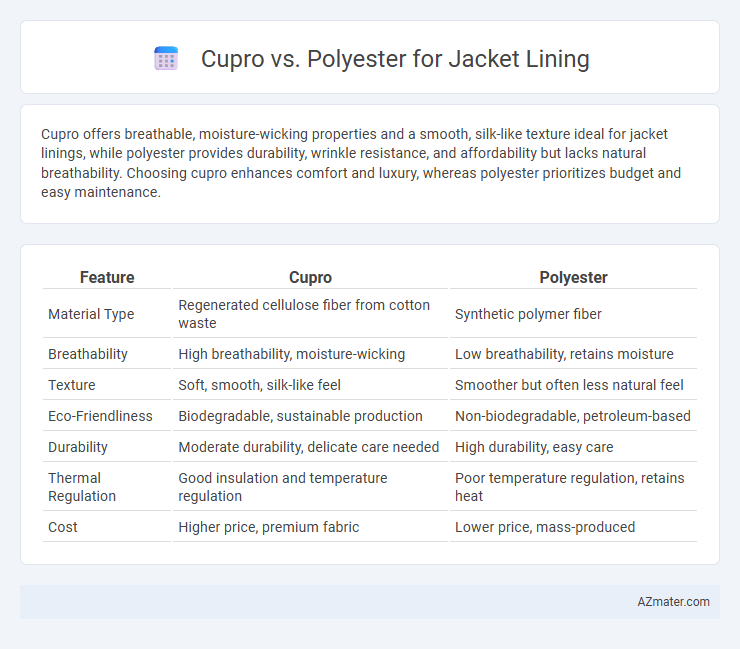Cupro offers breathable, moisture-wicking properties and a smooth, silk-like texture ideal for jacket linings, while polyester provides durability, wrinkle resistance, and affordability but lacks natural breathability. Choosing cupro enhances comfort and luxury, whereas polyester prioritizes budget and easy maintenance.
Table of Comparison
| Feature | Cupro | Polyester |
|---|---|---|
| Material Type | Regenerated cellulose fiber from cotton waste | Synthetic polymer fiber |
| Breathability | High breathability, moisture-wicking | Low breathability, retains moisture |
| Texture | Soft, smooth, silk-like feel | Smoother but often less natural feel |
| Eco-Friendliness | Biodegradable, sustainable production | Non-biodegradable, petroleum-based |
| Durability | Moderate durability, delicate care needed | High durability, easy care |
| Thermal Regulation | Good insulation and temperature regulation | Poor temperature regulation, retains heat |
| Cost | Higher price, premium fabric | Lower price, mass-produced |
Understanding Cupro and Polyester Fabrics
Cupro is a regenerated cellulose fiber derived from cotton linter, prized for its silky texture, breathability, and eco-friendly qualities, making it an excellent choice for jacket linings that require comfort and moisture absorption. Polyester, a synthetic fiber made from petroleum-based polymers, offers durability, resistance to wrinkles, and quick-drying properties but lacks the natural breathability and softness of cupro. Understanding these fabric characteristics helps in selecting the ideal jacket lining that balances comfort, sustainability, and performance according to specific garment needs.
Key Differences Between Cupro and Polyester
Cupro is a natural regenerated cellulose fiber derived from cotton linter, known for its breathability, moisture-wicking properties, and luxurious silk-like feel, making it ideal for jacket linings that require comfort and elegance. Polyester, a synthetic polymer, offers durability, wrinkle resistance, and cost-effectiveness but lacks the breathability and softness of cupro. Key differences between cupro and polyester include their origin--natural versus synthetic--their environmental impact, where cupro is more biodegradable, and their performance in moisture management, with cupro providing superior comfort in varying climates.
Breathability: Cupro vs Polyester
Cupro offers superior breathability compared to polyester, allowing better air circulation and moisture absorption, which reduces sweat and discomfort in jacket linings. Polyester tends to trap heat and moisture due to its synthetic fibers, making it less effective for temperature regulation. For jackets designed for active use or warm climates, cupro lining enhances comfort by promoting ventilation and dryness.
Moisture Management and Comfort
Cupro excels in moisture management due to its breathable and absorbent properties, wicking sweat away from the skin to keep the wearer dry and comfortable. Polyester, while durable and quick-drying, tends to trap heat and moisture, which can lead to discomfort during extended wear. For jacket lining, Cupro offers superior comfort with its smooth, natural feel and enhanced breathability compared to the synthetic texture of polyester.
Durability and Longevity Comparison
Cupro lining offers superior breathability and moisture-wicking properties, enhancing jacket comfort and durability by reducing wear from sweat accumulation. Polyester lining, known for its high tensile strength and resistance to abrasion, provides excellent longevity even in harsh conditions but may trap moisture, potentially shortening fabric life over time. Choosing Cupro prioritizes natural fiber benefits for extended comfort and longevity, while Polyester delivers robust durability ideal for strenuous use.
Sustainability and Environmental Impact
Cupro, a regenerated cellulose fiber derived from cotton linter waste, offers a biodegradable and eco-friendly alternative to polyester for jacket linings, reducing plastic pollution and reliance on fossil fuels. Polyester, a synthetic polymer made from petroleum, contributes significantly to microplastic pollution and poses challenges in biodegradability, leading to long-term environmental damage. Choosing cupro supports sustainable fashion initiatives by promoting resource efficiency and minimizing ecological footprints in textile production.
Touch, Feel, and Aesthetic Qualities
Cupro offers a smooth, silky touch that feels cool and breathable against the skin, making it ideal for jacket linings that prioritize comfort and luxury. Polyester linings, while more affordable and durable, tend to feel less natural with a slightly slick or synthetic texture, which can affect overall wearing comfort. Aesthetically, cupro showcases a subtle sheen and drapes elegantly, enhancing the jacket's sophistication, whereas polyester provides a consistent finish but often lacks the depth and refinement of cupro.
Ease of Care and Maintenance
Cupro jacket lining offers excellent breathability and natural moisture-wicking properties, making it easier to maintain without frequent laundering or specialized cleaning. Polyester linings, while durable and resistant to wrinkles and shrinking, often trap heat and can retain odors, requiring more regular washing and gentle care to avoid damage. Choosing cupro enhances ease of care through its natural fibers, whereas polyester demands more attention to maintain its appearance and performance over time.
Common Uses in Jacket Lining
Cupro is favored in jacket lining for its breathable, moisture-wicking properties that enhance comfort, making it ideal for high-end, tailored jackets and luxury outerwear. Polyester is widely used for jacket lining due to its durability, wrinkle resistance, and cost-effectiveness, commonly found in mass-produced casual and sports jackets. Both materials serve distinct purposes: cupro offers a natural, smooth feel for premium garments, while polyester provides a versatile, hard-wearing option suitable for everyday wear.
Choosing the Right Lining: Cupro or Polyester?
Cupro offers a breathable, moisture-wicking lining ideal for jackets worn in warmer climates, while polyester provides durability and resistance to wrinkles, making it suitable for everyday wear and colder weather. Cupro's natural, silky texture enhances comfort and luxury, but requires more delicate care compared to polyester's easy maintenance and affordability. Selecting between cupro and polyester depends on prioritizing breathability and comfort versus durability and cost-effectiveness for jacket lining.

Infographic: Cupro vs Polyester for Jacket Lining
 azmater.com
azmater.com